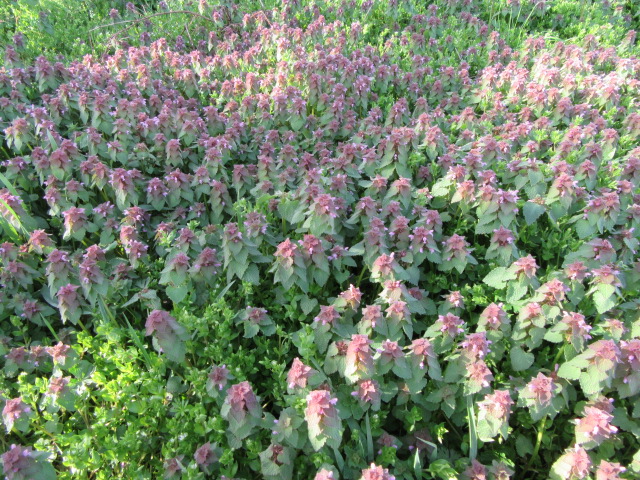
Lamium purpureum (Dead Nettle) behind the barn on 4-10-22..
Hello everyone! We had a thunderstorm move in a little after 1 AM on Tuesday night. With all the wind, rain, thunder, and lightning we still received less than 1/2″ of rain. The Weather Channel said the rain was supposed to stop at 1, so I waited until then to feed Kevin’s cows. It all but stopped when I left but started again at 1:30. Then at 1:45, I noticed a few tiny snowflakes that didn’t last long. I arrived at the other farm, where he lives, at about 2:15 with no rain or anything. Then, when I pulled up to the feed troughs, it started sleeting like mad! It lasted until I was finished then suddenly stopped. By the time I was back at the gate, the sun started shining. That was weird! The wind that had been blowing for DAYS calmed down.
This post is continued from the previous one where I had been looking for plants in the shade bed on Sunday, April 10. When I was finished, I started my walk to the back of the pasture. Actually, finding the morels among the Hosta triggered the desire to take the walk. Of course, I took my camera so I could call it a wildflower walk rather than a mushroom hunt. Just in case I didn’t find any. 🙂
Anyway, without further blabbing…
I walked around the barn and had to get a photo of a good-sized colony of Lamium purpureum (Dead Nettle) (top photo). It seems like this spot changes from year to year as far as what species is growing here. Just so happens, that it is the Dead Nettle’s turn. I am sure you have seen fields that have turned purple in the spring. It is either Lamium purpureum, Lamium amplexicaule (Henbit), or a combination of the two. They like each other and normally where you have one, there are a few of the other. Dead Nettle normally grows taller and the Henbit just seems to fill in the gaps. Of course, chickweed is usually there as well. I have been tempted to walk out into a field just to check.
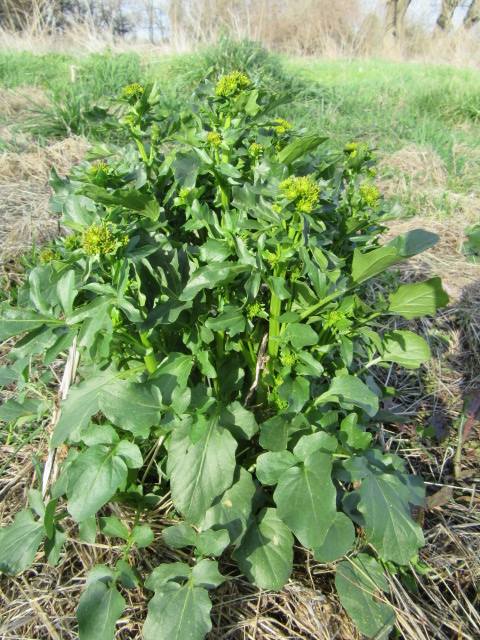
Barbarea vulgaris (Yellow Rocket/Bitter Wintercress).
Not far from the Lamium purpureum were a few Barbara vulgaris. One was just itching for me to take a photo. There are a few in the south hayfield whose flowers are already open. There are 10,473 Barbarea vulgaris on the farm (just guessing) all in a rush to produce seed. In the spring, the yellow flowers you see first out in the countryside are likely this species.
I ventured on to an area in front of the pond in the back pasture. Ummm, along a ditch that drains into the pond. I rarely go into this spot during the summer because of low branches and a few annoying Multiflora Roses and/or blackberry briars. I never really paid much attention to which. Closer to the pond is much easier access. Anyway, I went right in because it always seemed to be a good spot for “you know what” to be growing. I always look for activity from deer or wild turkeys because they like them, too. There was a lot of evidence of recent activity, so I started looking through the leaves. I found four…
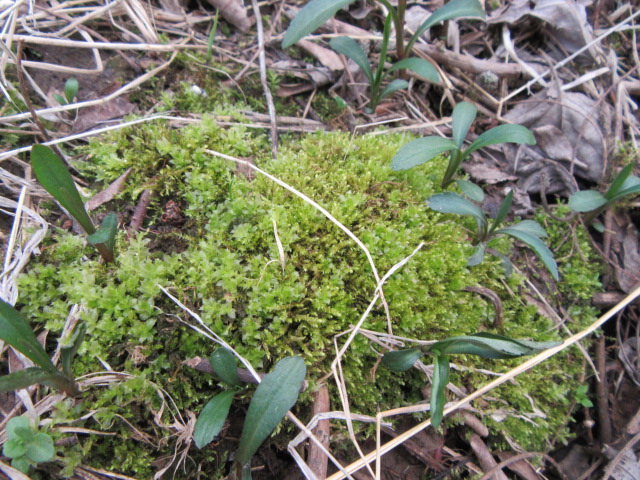
Physcomitrium pyriforme (Common Bladder Moss) on 4-10-22, #866-22.
Closer to the pond were several clumps of Physcomitrium pyriforme (Common Bladder Moss). Moss has always intrigued me and if I lived in the woods I would have it everywhere. There are several clumps in the north flower bed and along the north side of the garage. I submitted this photo to iNaturalist and the suggested species was Physcomitrium pyriforme (Commo Bladder Moss) and a couple of others. Other members had posted VERY detailed close-ups, so the next day I was in another area and I took a few close-up shots. I agree it is the Common Bladder Moss.
The plants growing among this clump of moss is a Solidago sp. (Goldenrod).
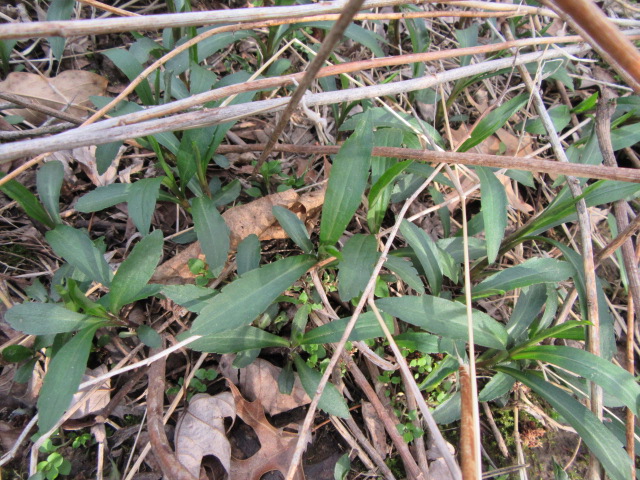
Solidago sp.
There is a HUGE colony of Solidago in this area and LOTS of it growing along the edge of the south hayfield, and several other areas. I like it, but it is kind of frustrating I haven’t figured out the species. S. altissima and S. gigantea are the two species I think they are. One or the other or both. They have similar symptoms (I mean, characteristics).
I crossed the fence behind the pond and walked along the creek for a while. The woods back there are becoming a briar jungle, just wasted space where an abundance of native plants could be growing that like dappled shade or open woods. When I was a kid, I used to hunt “you know what’ with my grandpa in this area. I haven’t found hardly any since and most years I find none. I think it was 2013 when I found this HUGE False Morel but I haven’t seen any of those since either. I need a photo!
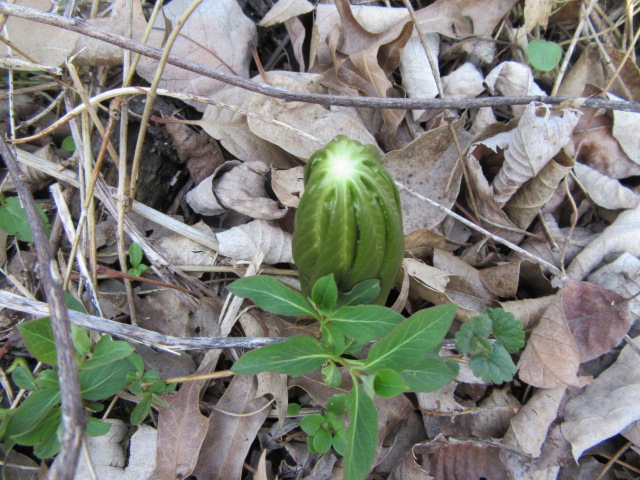
Podophyllum peltatum (Mayapple).
I ran across one of several colonies of Podophyllum peltatum (Mayapple) that apparently hadn’t been up long. I had never seen any this small, which is kind of odd. Another thing I have heard is that when the Mapapples start to bloom then you will find “you know what.” Well, they are a long way from blooming…
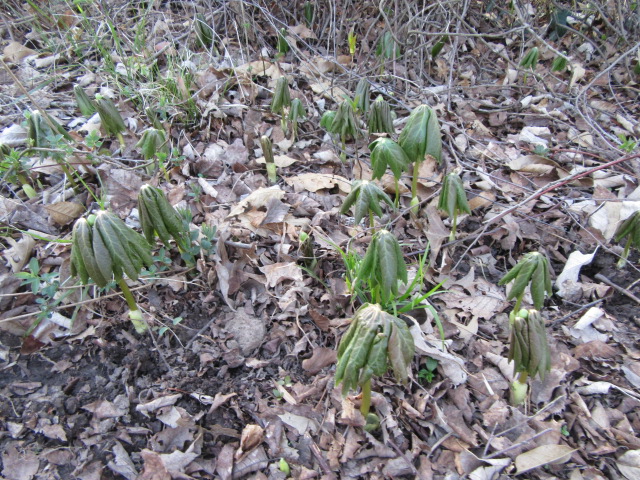
Podophyllum peltatum (Mayapple).
A little farther down was another colony that had leaved out more but they look a little off. Like that had been “F” bit. You know what I mean. 🙂 The word I don’t use in the fall applies in the spring as well.
So, I walked back toward the house to take a few wildflower photos.
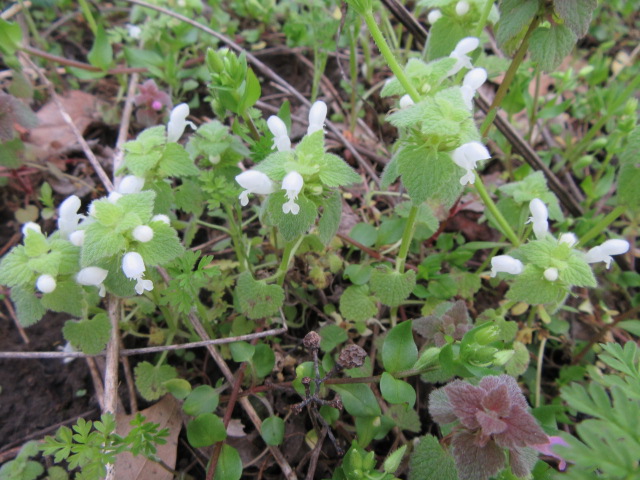
Lamium purpureum (Dead Nettle).
The white-flowered Lamium purpureum first showed up in the spring of 2020 in the area northeast of the chicken house. There were only a few the first year but they have multiplied quite a bit. I am not sure how common Dead Nettle with white flowers are, but this is the only spot I have ever seen them. It is quite a treat but rather odd. How about you? Have you ran across any with white flowers? Information online says they can be pale pink, lavender, pinkish-purple, or white…
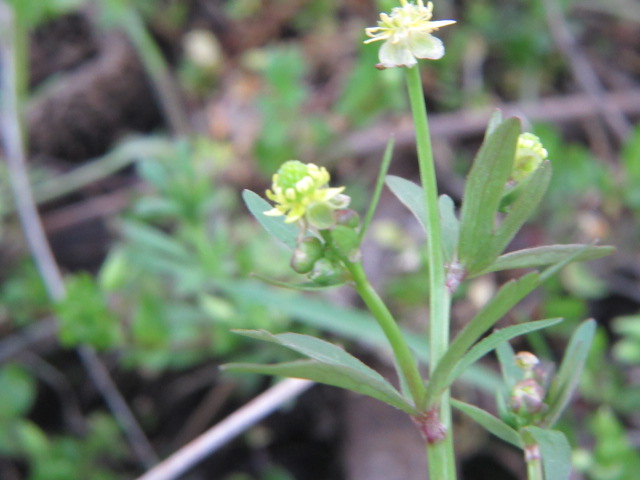
Ranunculus abortivus (Small-Flowered Buttercup) on 4-10-22, #866-25.
I stumbled on this Ranunculus abortivus (Small-Flowered Buttercup) along the fence in the same area as the white-flowered Dead Nettle a few days ago. Well, heck, it is a few days ago when I took the photo. Anyway, it was last week when I first saw it. I needed to get better flower close-ups for this species so I thought I would give it a shot.

Ranunculus abortivus (Small-Flowered Buttercup) on 4-10-22, #866-27.
This one is pretty good despite it bobbing around in the wind. I could pass for a living manikin waiting for the wind to stop for a few seconds, kind of like a dog on point… I had to keep pressing the trigger to keep it in focus. There are several of this species on the farm, and I even found one in the backyard when I was mowing today (April 14). Of course, I mowed around it. Well, it takes a lot of effort to grow like that.
Identifying Ranunculus species drives me a little crazy. There are two species, I think, that look like this but I am pretty sure I have it correct because of their flowering time. This one is pretty easy. The others… Well, there are three more here that I am maybe 60-75% sure of. If there were more than 3-4, I would check myself in.
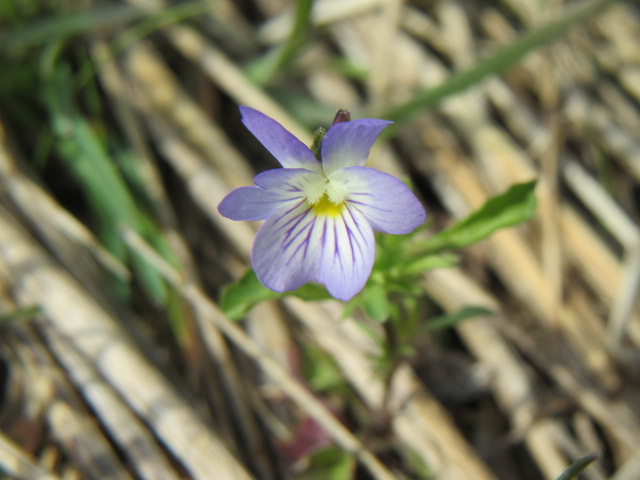
Viola rafinesquei (American Field Pansy).
The Viola rafinesquei (American Field Pansy) has the best-looking flowers of the four species of Viola I have identified. The above photo was taken on April 4 at the entrance of the south hayfield but I didn’t get good photos of the leaves and stems. There is a good-sized colony north of the chicken house, so I stopped there to get more photos. This spring I have noticed more of this species than ever before, almost as many as Viola sororia (Common Blue Violet).
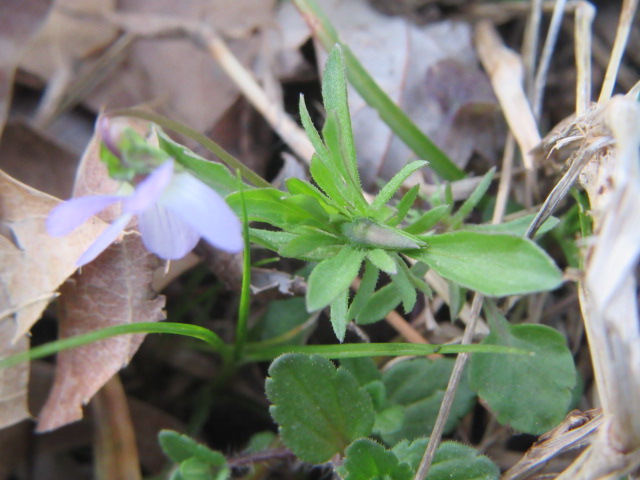
Viola rafinesquei (American Field Pansy).
These don’t have the typical “Violet-looking” leaves as the others I have identified.
If you think the flower looks similar to a Johnny-Jump-Up, you would be correct. Johnny-Jump-Up is the common name for Viola bicolor Pursh which was named by Frederick Traugott Pursh in 1813. That name became a synonym of Viola rafinesquei which was named by ‘ol what’s his name… Umm… Edward Lee Greene in 1899. It’s kind of a confusing story, but there was another Viola bicolor named by a guy named Hoffman that became a synonym of Linnaeus’s Viola tricolor. I think Hoffman was confused and could have been looking at Viola tricolor with bicolor flowers. Well, sometimes V. tricolor produces bicolor flowers. GEEZ! Anyway, somehow, even though Pursh’s V. bicolor was named before Hoffman’s V. rafinesquei, the latter name is listed as accepted by Kew Science. I suppose common names of the synonyms get transferred to the accepted species as “other” common names. There are still quite a few websites and databases that use the name Viola bicolor which is perfectly fine. They don’t have to agree. Possibly, both species were accepted for over 100 years before botanists or testing decided they were the same species.
The Missouri Plants website lists 12 species of Viola in Missouri.
OK, I am finished with this post now.
Until next time… Be safe, stay positive, and always be thankful. I think it is about time to GET DIRTY!
Twelve species of Viola in Missouri: yikes!
LikeLiked by 1 person
Hello Steve! I miscounted. There are 13. 🙂 Take care and thanks for the comment! HAPPY HUNTING!
LikeLike
Call it not a baker’s but a botanist’s dozen.
LikeLiked by 1 person
Indeed!
LikeLike
Mayapples are so unique! I have so many plants you show and never know the name. Thank you for posting the names. I have plenty of Dead Nettle that seems to love our garden. Lol
LikeLiked by 1 person
Hello Diane! Mayapples are definitely neat plants. The Deadnettle always does very well here and always on time for the early bees. I am glad the post helped with a little plant ID. Take care and thanks for the comment!
LikeLike